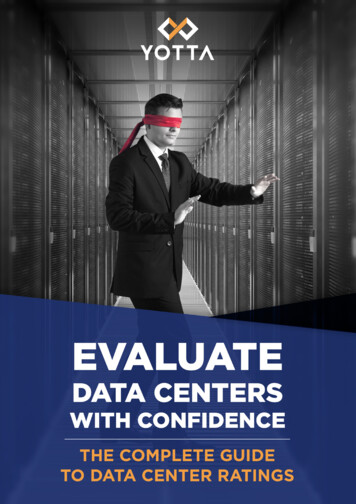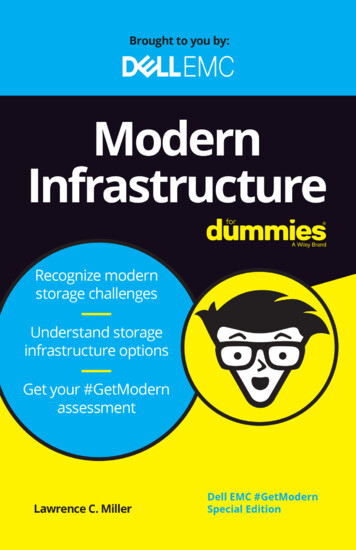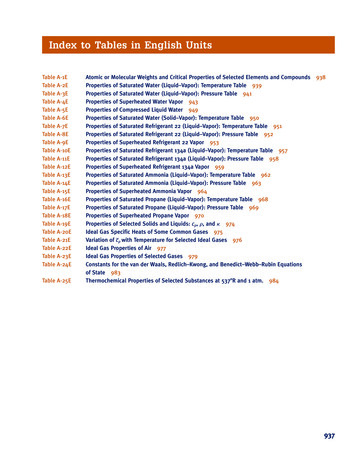
Transcription
TABLE OF CONTENTSForeword3Data Centers – The core nerve centerfor your digital journey4Data Center Certifications and their need6Popular Data Center Tier ratingcertification providers7Understanding Uptime Institute TierCertification (UTI)7Uptime Institute Tier Standards9Understanding TelecommunicationsIndustry Association – TIA-942 Certification11Types of ANSI/TIA-942 Certification12Snapshot - Uptime Institute andTIA-94212TIA-942 and Uptime Institute the difference13Why Uptime Institute rating matters andshould you make the move to Tier IVdata center?13A look at Asia’s largest and World’sSecond-largest Uptime Institute Tier IVdesigned Data Center – what sets it apart?15
FOREWORDData Centers are the nervous system ofthe digital economy. All businesses, largeor small, rely on data centers for theiroperations. Data Centers have come a longway; today, they are not just a brick-andmortar building housing IT equipment. DataCenters store, analyse, deliver, protect andcompute your data/workloads.The data center or the colocation provideryou select is as equally important asthe hardware you choose to run yourapplications on. You will not want to hostor run your apps on hardware that isobsolete or offers sub-par performance.Similarly, to meet the growing demandsof business, you do not want to be stuckwith a colocation provider of yesteryear.There are various other essential factorsthat you should look in to. With 5Gknocking our doors, cloud computing andremote collaborative working becomingthe new norm, making the right choice ofa data center is more important than ever.With companies turning to cloud-basedsolutions for their remote workforce,big-time content consumption via OTT3platforms and online learning/schoolingare giving impetus to data centers.This whitepaper aims to guide you onvarious types of data center Tier ratings,how the performance of data centeris measured, what to look in for whileselecting the colocation provider, and whatare Tier levels and Institutes that rate datacenters.This whitepaper also highlights theconcepts of MTDCs or Data Colocationproviders and lastly, gives insight intoAsia’s largest and World’s second-largestUptime Institute Certified Tier IV datacenter.Happy Reading!Sunil Gupta
DATA CENTERS – THE CORE NERVE CENTERFOR YOUR DIGITAL JOURNEYIT infrastructure plays an important role toensure business continuity. Amidst crisis,we have seen how Data Centers haveensured cloud services, remote connectivityand data accessibility to enterprisesand customers. Most organisations arenow adopting cloud and are looking tofocus on their core services instead ofmanaging their IT, in-house. Data Centersare the first step for businesses who arestarting their digital transformation journey.The need for always available and scalableIT infrastructure is crucial for businesses tofunction. As the reliance on technology hasincreased, one has to select a data centerprovider with utmost evaluation.GROWING ADOPTION OF MULTI-TENANTDATA CENTERSYou would have come across the terms,Multi-Tenant Data Center (MTDC) orThird-Party colocation providers quiteoften. As the name suggests, multi-tenantmeans where your servers, IT equipmentreside with other enterprises, sharing thereal-estate of the data center provider.Besides, a multi-tenant data centeroffers enterprises with multiple internetconnectivity options and has significantlylower power cost as compared to a captivedata center. As per 451 Research, AsiaPacific leads with the fastest leaseddata center market growth of 9% from2016-2022.Enterprises are continuing to shift from thecaptive or self-built data center to third partycolocation providers. Reasoning the need tomove to the cloud as one of the most criticalIT strategies, enterprises are leveragingcolocation services to ramp up their cloudjourney. At the same time, Hyperscalers andCloud Service Providers are looking to leasecustom build MTDC facilities that providethem long term scalability without havingto invest heavily upfront.COLOCATION TYPES AT A MTDCRack space:Dedicated Racks of various sizes like42U/45U/48U/52U are available along withUnit (1U, 2U and more).Server rack cage:Need additional security and compliance?Ask for server rack cage that is completelycustomised and configured as per yourrequirement.Dedicated server hall/suite:Data centers also provide exclusive suitesor rooms to house your servers and ITequipment.Dedicated server floor space:With a dedicated floor space, get fullcustomisation and control on security,cabling, and power.4
HYPERSCALE DATA CENTER PARKSHyperscale means enormous scalability.Everything about hyperscale data centersis virtually unlimited. Space, Power,Connectivity, and Availability are the crucialfactors that are found aplenty at hyperscaledata centers. Hyperscale data center parks,instead of a data center building havemultiple buildings on the same campus.This makes it easy for businesses toexpand at the same site, thus offering themlongevity in terms of their IT investmentsand can scale up and down as per theirneed. Hyperscale data center operatorshave better resources and provide multipleand massive bandwidth to support cloudservice providers, who generally look forhigh-volume data transfers and storage.AERIAL VIEW OF YOTTA DATA CENTER PARK AT NAVI MUMBAIADVANTAGES OF MTDCs OVER ON-PREMISECAPTIVE DCsScalability & Agility - an integratedand cost-effective IT infrastructure,scalability as per your needs andagility to adapt to new requirementsor technology upgrade.Faster Go to Market - As comparedto a captive data center, with MTDCs,you can migrate as and when needed.This provides faster go-to-market foryour business.Cost-Effective - Even operating aserver rack on-premises is a costlyaffair. Imagine this where you havemultiple racks. A captive data centereats up a lot of upfront investments;at the same time, it does not offer the5liberty to scale-up or scale-down asper your requirement. For instance,if you have unutilised racks, in anMTDC, you can surrender those to theprovider without incurring additionalexpense. On the other hand, if youneed to expand, you can lease morespace from the provider.Security & Reliability - The lifelineof any business – data, needs to besecured and accessible to ensurebusiness continuity. An MTDC investsin multi-layer of security and protectsthe server racks from unauthorisedaccess, both physical and virtual. Forcyberthreats, MTDCs have a bettercapability and protection than as
a business you would invest in tokeep your data secure. Additionally,to meet compliance standards andcertifications, data center operatorshave an extensive, layered structure.Even if the intruder manages tobreach one-layer, other layers mayprevent the compromise of the entiresystem or alarm the management ofthe breach.Power - The most critical factor ofa data center. MTDCs generally getuninterrupted power. For backup,MTDCs have generator sets on site.However, as a customer, you shouldbe asking the MTDC about thecapacity of power they can provideat the site? Do they have power substation on their campus? Do theyhave the ability to operate the sitewithout interruption for days on thebackup power? Are UPSes redundantand more?Connectivity - Network connectivityneeds are as unique as us. Generally,MTDCs offer multiple telecoms andnetwork connectivity options. With acaptive data center, you need to usethe available service provider, henceyou do not get options. However,since MTDCs offer major telecom andnetwork operators, you can select thebest as per your requirement or evengo with the one you already use.High Availability - MTDCs aregenerally designed with resiliency andredundant IT architecture. Businessescannot afford any downtime and dueto the redundant fail-safe architecture,MTDCs offer high availability of powerand cooling for IT equipment.Shared Resources - As one of thetenants along with many others, youbenefit from the shared resources.For instance, security, power, networkconnectivity, real estate, and manyother factors that otherwise are costlyto maintain in a captive data center,are affordable with an MTDC.DATA CENTER CERTIFICATIONS ANDTHEIR NEEDBusinesses today rely on the data centerand its supplementing services. Hence,it becomes imperative to have the bestdata center to host and manage yourcritical infrastructure. Your data centeror colocation provider needs to assureyou of their guaranteed performance. TheSLA should provide the uptime of yourserver racks and IT equipment. In case of adisaster or crisis, is the colocation providerequipped to ensure business continuity?Hence, data centers are rated as pertheir Tier levels via different types ofcertifications. These Tier levels determinethe performance and uptime guaranteelevel of data centers. They also provide youwith an overview that a data center meets apre-determined list of standards laid by thecertification agencies/institutes.For data centers or colocation providers,these certifications help them to designand operate their facilities in line with thebest practices globally.6
POPULAR DATA CENTER TIER RATINGCERTIFICATION PROVIDERSWhen looking at colocation providers, youoften come across Tier ratings. Colocationfacilities or data centers need to beaccredited with performance certificationby experts who specialise in this. However,withtoomanyaccreditationsandguidelines, it becomes difficult andconfusing to select the best. The mostpopular Tier rating providers are UptimeInstitute (UTI) and TelecommunicationsIndustry Association (TIA).are time-consuming and involve a lot ofcapital expenditure. Hence, most of thecolocation providers skip the certificationprocess or settle with the one that theycan certify via some third-party agencies/vendors.These Tier certifications are also dependenton other factors, like where the data centeris located. Although there are advantagesto go in for a Tier rating certification,however, on the flip side, these certificationsUNDERSTANDING UPTIME INSTITUTE TIERCERTIFICATION (UTI)Uptime Institute is the most commonname for Data Center Tier certification.They specialise in the certification of datacenter design, construction, and operation.They even offer specialised training fordata center service providers. The UptimeInstitute Tier certifications are widelyrecognised and accepted by customers anddata centers, alike. Uptime Institute hasawarded over 1600 Tier Certifications inover 100 countries and trained thousandsof professionals with their Accredited TierTraining programs.Uptime Institute Tier Certification fordata centers is the de-facto gold-standardworldwide for evaluating the quality ofmission-critical data centers. It is the onlycertification in the world which is outcomebased, assesses and certifies Data CentersonperformanceandcontinuityofOperations, as against some other7prevailing standards which only conformto the compliance of data center againsta prescriptive checklist of components,but do not certify the data center for itsperformance and continuity of operations.Uptime Institute certifies data centers viaits Tier classification that ranges from TierI to Tier IV, from being more stringent andfault tolerant. These Tier Standards are anunbiased set of infrastructure and operatingcriteria which are certified by UptimeInstitute’s panel of officers, unlike any thirdparty consultants.
The Tier classifications describe the sitelevel infrastructure topology requiredto sustain data center operations, notthe characteristics of individual systemsor subsystems. The Tier Standard ispredicated on the fact that data centersare dependent upon the successful andintegrated operation of several separatesite infrastructure subsystems, the numberof which is dependent upon the individualtechnologies like power generation, cooling,uninterrupted power sources selected tosustain the operation. Every subsystemand system integrated into the data centersite infrastructure must be consistently deployed with the same uptime objectiveto satisfy the distinctive Tier requirements.Compliance with the requirements ofeach Tier is measured by outcome-basedconfirmation tests and operational impacts.This method of measurement differs from aprescriptive design approach or a checklistof required equipment.The purpose of this standard is toequip design professionals, data centeroperators, and non-technical managerswith an objective and effective means foridentifying the anticipated performanceof different data center site infrastructuredesign topologies.WHAT MAKES UPTIME INSTITUTE TIERCERTIFICATION UNIQUE?Performance-based:Uptime Institute defines its TierStandards on performance. It ratesthe data center on factors likeavailability, redundancy, and fault.Technology agnostic:Uptime Institute’s Tier classificationdoes not rely on a single or particulartechnology. The end focus is theperformance and operational result.One can achieve the end-result viainnovative and smart engineering,rather than following a linearprocess.Vendor agnostic:Colocation providers or facilitybuilders can use any preferredbrands or hardware or IT equipment.Uptime Institute does not endorseor recommend a brand.Flexible:Despite compliances and processes,one has the freedom to adhere tolocal rules and regulations of thestate/country while achieving theirTier certification goal.Lifecycle:Starting with the right design withthe Tier Standard in the DesignDocument phase and continuingwith the Constructed Facility andOperational Sustainability phases,the Tier Standard covers thecomplete lifecycle of a facility.Certification:Uptime Institute administers andmonitors its standards via a teamof experts. The Tier Certificationprescribed by them is not just atextbook process to follow, insteadit is goal and performance-based.(Source: https://uptimeinstitute.com/tier-certification)8
UPTIME INSTITUTE TIER CERTIFICATION TYPESTier Certification ofData Center DesignDocuments – Beforeconstructing the facility,the design of the datacenter must meet theend performance goal.The design documentsof the data center are submitted to theUptime Institute, which contains answersto the questions about a ll primaryinfrastructure. It also requires the colocationprovider to provide the topologicalarchitecture of IT and networks. Thiscertification covers mechanical, structural,electrical, and other site elements. Theseare reviewed by Uptime Institute, whereinthey provide consulting support to thecolocation provider for a final designcompliant with the Tier rating. The TierCertification of Design Documents is validfor two years from the date of issue.Tier Certification ofConstructedDataCenter Facility – Thiscertificationvalidatesthat the data center hasbeen constructed as perthe approved design andbasis the ates the performance of the facilitywith live demonstrations of critical systemsunder real-world conditions. This helps thecolocation provider to focus on identifyingand addressing construction issues beforecommencing the facility operations.Within two years, the facility should go infor Tier Certification of Constructed DataCenter Facility. The awarded validity ofthe certificate can be checked at UptimeInstitute’s website.For instance, Yotta NM1, which was awarded theTier IV certification for design, can be verified here fData Center OperationalSustainability–Thiscertification asseses practices.Anycompromiseonreliability and performance are highlightedso that colocation providers can focus onachieving the best operational practicesto attain the full potential of installedinfrastructure.UPTIME INSTITUTE TIER STANDARDSTier I: Basic Site Infrastructure – A TierI basic data center has non-redundantcapacity components, and a single, nonredundant distribution path serving thecritical environment. Tier I infrastructureincludes a dedicated space for IT systems,a UPS to filter power spikes, sags, andmomentary outages, dedicated coolingequipment, and on-site power production9to protect IT functions from extendedpower outages. These data centers have12 hours of on-site fuel storage for on-sitepower production. As the site is susceptibleto disruption from both planned andunplanned activities, the infrastructuremust be completely shut down on an annualbasis to perform necessary preventivemaintenance and repair work safely.
Uptime Institute Tier Rating SystemTier IV: Fully Fault Tolerant & RedundantTier III: Fault Tolerant, Multiple power sourcesTier II: Redundant InfrastructureTier I: Dedicated Infrastructure, LacksRedundancies, CheaperTier II: Redundant Site InfrastructureCapacity Components – A Tier II datacenter has redundant capacity componentsand a single, non-redundant distributionpath serving the critical environment.The redundant components are extra onsite power production, UPS modules, andenergy storage, chillers, heat rejectionequipment, pumps, cooling units, and fueltanks. These data centers have 12 hoursof on-site fuel storage for ‘N’ capacity. Asthe site is susceptible to disruption fromboth planned and unplanned activities,the infrastructure must be completelyshut down on an annual basis to performnecessary preventive maintenance andrepair work safely.Tier III: Concurrently Maintainable SiteInfrastructure – A Tier III data center hasredundant capacity components andmultiple independent distribution pathsserving the critical environment. For theelectrical power backbone and mechanicaldistribution path, only one distribution pathis required to serve the critical environmentat any time. All IT equipment is dualpowered and installed correctly to becompatible with the topology of the site’sarchitecture. Transfer devices, such as pointof-use switches, must be incorporated forthe critical environment that does not meetthis requirement. These data centers have 12hours of on-site fuel storage for ‘N’ capacity.As the site is susceptible to disruption fromboth planned and unplanned activities,planned site infrastructure maintenancecan be performed by using the redundantcapacity components and distributionpaths to safely work on the remainingequipment.Tier IV: Fault Tolerant Site Infrastructure –A Tier IV data center has multiple,independent, physically isolated systemsthatprovideredundantcapacitycomponents and multiple, neouslyservingthecriticalenvironment. The redundant capacitycomponents and diverse distribution pathsshall be configured such that ‘N’ capacityis providing power and cooling to thecritical environment after any infrastructurefailure. All IT equipment is dual poweredwith a Fault tolerant power design internalto the unit and installed properly to becompatible with the topology of the site’sarchitecture. The site is not susceptible todisruption from a single unplanned eventand any planned work activities.10
UNDERSTANDING TELECOMMUNICATIONSINDUSTRY ASSOCIATION - TIA-942 CERTIFICATIONAnother popular certification provider –Telecommunications Industry Association’s- TIA-942 certification was developed bythe American National Standards Institute(ANSI) in 2005. It lays out the guidelines forplanning and building telecom infrastructurelike data centers. The ANSI/TIA-942standard provides an inclusive understandingof data center design to plan the facility,network, and the cabling system. It alsocovers physical data center that includesarchitecture (facility location, safetyand security, fire suppression) electrical,mechanicalandtelecommunicationsystems. Unlike the Uptime Institutewhich acts a certifying body, TIA-942certifications are validated by s. The requirements areorganised in four rating classifications,termed as Rated 1, Rated 2, Rated 3 andRated 4.RatedRatedRatedRated4321 Fault Tolerant;Redundant Concurrentmaintainabilitywith 1 faultanywhere inthe installationwithout causingdowntime ConcurrentlyMaintainablewith Redundantcapacitycomponents Multipleindependentdistribution paths RedundantCapacityComponents SingleNon-Redundantdistribution path Single capacitycomponents Non-Redundantdistribution pathTIA-942 Rated LevelTIA-942 ratings have been arrived out ofUptime Institute standards; hence, both,Uptime Institute Tier IV rating and TIA-942Rated 4 appear to be identical. TIA-942 alsoused Tier level indications like the Uptime11Institute, however from 2014, TIA-942started using the term ‘Rated’ to separateitself from the Uptime Institute’s Tierrating system.
TYPES OF ANSI/TIA-942 CERTIFICATIONANSI/TIA-942 Design Certification:This status indicates that the designdocuments of the data center under scopehave been reviewed for conformity tothe design criteria of the ANSI/TIA-942standard for the respective Rating level.The ANSI/TIA-942 design certification isvalid for one year, extendable if a site is notoperational yet.ANSI/TIA-942 Facilities Certification:This status indicates that the data centerfacility under scope has been physicallyinspected for conformity to the designcriteria of the ANSI/TIA-942 standard forthe respective Rating level. This physicalinspection covers both an assessment ofall related design documents as well as aphysical on-site inspection for each areaunder the scope of the ANSI/TIA-942standard. The ANSI/TIA-942 FacilitiesCertification is valid for 3 years. By the endof year-1 and year-2, the data center shouldundergo a surveillance audit. By the end ofyear-3, the data center has to undergo a recertification audit to keep its certificationvalid.ANSI/TIA-942 Ready:This status indicates that a product,typically a modular data center such as prefabricated data center or a container baseddata center product has been designedin accordance to the requirements of theANSI/TIA-942 standard for the respectiveRating level. This certification will ensurethat once the modular data center solutionhas been placed in the appropriateenvironment that it will meet the indicatedRating level. The ANSI/TIA-942 ReadyCertification is valid for one year with yearlyre-certification.(Source: SHOT - UPTIME INSTITUTE AND TIA-942DESCRIPTIONUPTIME INSTITUTETIA-942Tier-I Basic CapacityRated 1 BasicTier-II Redundant ComponentsRated 2 Redundant ComponentsTier-III Concurrently MaintainableRated 3 Concurrently MaintainableTier-IV Fault TolerantRated 4 Fault TolerantRating MethodMeasured on Performance andOperation impactsBased on Reference Guides andcheck-listsCoversElectrical, Mechanical, andAncillary (engine generator, fuelsystem, make-up water system,building automation system)Telecommunications, Electrical,Architectural, and Mechanical(TEAM)Tier ClassificationTypes of Certification Tier Certification DesignDocuments (TCDD) Tier Certification ConstructedFacility (TCCF) Tier Certification OperationalSustainability (TCOS)Design - Conforms to the designcriteria of ANSI/TIA-942Facilities - The facility and relateddesign documents have beenphysically onsite inspectedReady - Typically a modular datacenter, has been designed inaccordance to ANSI/TIA-942Source - TIA942.orgCertification Agency/InstituteUptimeAuthorised third-party agency by TIA12
TIA-942 AND UPTIME INSTITUTE - THE DIFFERENCEThe debate between Uptime Institute andTIA-942 ratings have been ongoing sinceages. At the surface, both the UptimeInstitute and TIA-942 Tier ratings seemsimilar. However, there are differences interms of usage of equipment, for instance,Uptime Institute requires the use ofcontinuously rated or data center ratedgenerators. At the same time, TIA-942permits the use of standby or replacementrated generators. In terms of cooling,which plays a vital role in a data center,Uptime Institute requires that the datacenters cooling capacities should be ableto handle extreme conditions based onthe data center location. At the same time,the TIA-942 standard is not as stringentin this department. As mentioned earlier,unlike Uptime Institute that evaluates andcertifies the facility themselves, TIA-942certifications are provided by third-partyauditors authorised by TIA.WHY UPTIME INSTITUTE RATING MATTERS ANDSHOULD YOU MAKE THE MOVE TO TIER IV DATACENTER?According to Ponemon Study, the averagecost of unplanned data center outage is 9000 per minute; this figure has increasedconsiderably as you read this. With clouddependency, smartphone usage, onlineshopping and remote working becomingthe new norm, businesses cannot takechances with their IT infrastructure facilitiesfor business continuity. Uptime Instituterates the data center as per its availabilityto serve the critical requirements of itscustomer, that is, the uptime of the alcalamity,ITequipmentfailure,fireandmore. While all Tiers by Uptime Instituteoffer more than 99% of uptime, you will besurprised to see the real-world differenceof all Tiers, that is Tier I to Tier III against a13Tier IV data center and how it can impactyour business. For instance, a Tier I datacenter can have a downtime of average28.8 hours per year, that is more than aday lost, which can translate to a loss ofmillions for a business. A Tier II data centerhas a downtime of average 22 hoursper year which is also considerably more.The most common data centers that arefound are Tier III, they have average 1.6hours of downtime per year, in comparisonto Tier IV data centers that have justalmost 100% of uptime and have onlyaverage 26.3 minutes of downtime perannum for purposes of optimisingoperations and due to the fault tolerantand redundant design, these data centersdo not impact customers hosted there.
It is business as usual for years and years, asthe 26.3 minutes downtime is average andtherefore in actual conditions there may notbe any downtime for consecutive years.Uptime Institute certified Tier IV designeddata centers ensure efficiency. With bettertemperature control and consistency, yourIT hardware like servers tend to benefitwith extended life, and above all, there areno downtimes for you. One of the commonmyths that many people have is that colocating at Tier IV data centers is costlierthan a Tier III data center. Data center likeYotta NM1, which is a part of the Yotta DataCenter Park is an Uptime Institute Tier IVdesigned data center that offers colocationthat is at par with Tier III data center costand with quality and reliability of Tier IV.Also, not every Tier IV data centers aresame. The operational side is as important asthe design. Most of the time, infrastructurefailure occurs because of people and notbecause of equipment. Hence, other factorslike IT workforce employed by the DataCenter, Financial health of the provider,scalable operation, geographical presence,adhering to compliances and more needsto be considered. The cherry on the cakeis also when the Tier IV data center is ahyper-scale facility. This ensures you canscale vertically or horizontally as per yourbusiness needs. To lure customers, manyData Centers or colocation providersmarket themselves as Tier Rated 4 or Tiercompliant. This generally is done to takeadvantage of customers novice knowledgeabout data center tier ratings. Whenin doubt, ask the provider to producetheir certification foil. Most importantly,remember you will be using the data centerand its services for the long term, at leasta minimum of 36-months to 60-months.Hence, go with a colocation provider thatis accredited with Tier IV certification,this ensures you guaranteed uptime andstamps the reliability.14
A LOOK AT ASIA’S LARGEST ANDWORLD’S SECOND-LARGEST UPTIMEINSTITUTE TIER IV DESIGNED DATACENTER – WHAT SETS IT APART?Various technical features differentiate Yotta NM1 Data Center with the other data centers,which may be non-certified or self-certified or certified by third parties (and not by thecertification body itself) or rated against any different standards are enumerated below:15
Concurrently MaintainableUptime Institute Tier IV certification builds on the top of Tier III certification criteria ofConcurrent maintainability, wherein all the MEP equipment are required to be deployed inminimum N 1 redundant configuration, so that any maintenance activity can be carried outon any single equipment without causing any downtime to any IT load within the data center.Likewise, all the power and chilled-water distribution paths are required to be deployed inN N redundant configuration, to ensure any planned or unplanned maintenance activityon such paths. To meet these equirements, the design of Yotta NM1 includes redundanciesat every single level as per the following:N N CONFIGURATIONN 1 CONFIGURATIONIncoming HT, Utility Feeders, UPSes,PDUs, UPSes for Pumps and PAHUs, FuelPumps and distribution piping in N N(1W 1S) configuration, BMS with PLCsfor monitoring working in active/inactivemode, Additional PLCs for controlfunctionsAir-cooled Chillers, Centrifugal in-linePumps, Precision Air Handling Units(PAHU), Distribution Transformers inN 2 configuration. Generators in N 2configuration and Dual-path of feedof electrical power and chilled watersupply to each loadFault-TolerantTo comply with Uptime Institute Tier-IV certification requirements, this is the main additionalrequirement above and beyond Tier-III certification criteria, wherein any sudden fault in thepower and cooling systems, should result in the automatic transfer of the entire IT andcooling loads to the standby equipment, through redundant distribution path, without anydowntime to any Server Racks. Such faults include many things including, for example, anyleakage (small or big) in the chilled water pipelines, apart from the failure of power andcooling equipment. Accordingly, any such incidence of leakage in the piping should beautomatically detected, isolated, arrested and contain
Understanding Telecommunications Industry Association – TIA-942 Certification Types of ANSI/TIA-942 Certification Snapshot - Uptime Institute and TIA-942 TIA-942 and Uptime Institute - the difference Why Uptime Institute rating matters and should you make the move to










